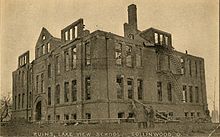- Collinwood school fire
-
The Collinwood school fire (also known as the Lake View School fire) of Ash Wednesday, March 4, 1908, was one of the deadliest disasters of its type in the United States. 172 students, two teachers and a rescuer were killed in the conflagration in Collinwood, Ohio, a community that has since been absorbed into the city of Cleveland.
While the Lake View School was built with load-bearing masonry outer walls, much of the four story building's floor structure system used wooden joists. It was one wooden joist that caught fire when it was overheated by a steam pipe. The building’s main stair case extended from the front doors of the building, up to the third floor; without benefit of fire doors. The stairwell acted like a chimney, helping to spread the fire quickly. Oiled wooden hall and classroom floors also fueled the fire.
A common misconception about the building's design is that the doors opened inward. They did not, as has been verified in accounts of the fire written at the time. Doors to the building were equipped with common door knob latches, not the more modern crash bar type latch. As panic leading to the crush of a large number of students in stairwell vestibules contributed to the death toll, students also died as a result of smoke inhalation and the fire itself. Some children died jumping from second- and third-story windows. Community members watched as victims trapped in the building were burned beyond recognition.
Contents
Aftermath
Those killed in the fire who could not be individually identified, as well as those students whose parents could not afford a burial, were buried in a mass grave in Cleveland's Lake View Cemetery. Additionally, several families who lost their children in the fire chose to bury their children's remains adjacent to the Collinwood victims.[1]
Following the fire, the remains of the Lake View School were demolished and a memorial garden planned for the site. A new school—Collinwood Memorial Elementary School—was built adjacent to the disaster site, and incorporated many features that had been lacking in the previous building. Unlike the building involved in the disaster, the new school incorporated fire safe stairwells, a central alarm system, and was built of steel framing and other fire-safe materials. Although the new school was torn down in 2004, a memorial plaque remains on the site as new development is added to the area.
The disaster also led to a national effort to change doors at public buildings so that they opened outward. It was thought about after the Iroquois Theatre Fire. They also made "panic bar" latches on doors required in all schools. The final casualty of the fire was the independence of the Collinwood community itself. Unable to sufficiently guarantee fire safety resources for its residents, voters approved an annexation of Collinwood into Cleveland within two years of the fire.[citation needed]
See also
References
- ^ "Film of the fire and the burial". Provided by the Library of Congress and the Cleveland Public Library. http://www.youtube.com/watch?v=-KQU-DR9z2c. Retrieved 2009-02-06.
Further reading
Bellamy, John Stark II (1997). Maniac in the Bushes: More Tales of Cleveland Woe. Cleveland, OH: Gray & Company, Publishers. ISBN 978-1-886228-19-1
External links
- Encyclopedia of Cleveland entry: Collinwood School Fire
- Dead Ohio Collinwood School Fire
- Collinwood Fire Memorial Sculpture, Lakeview Cemetery
- Sun Newspaper’s 90th anniversary coverage
- Cleveland Plain Dealer's 100th anniversary coverage
- New Memorial School built on the premises of Lakeview/ Old Memorial School.
- Collingwood School Memorial at Findagrave
- Ash Wednesday at Making Light
Coordinates: 41°34′17″N 81°34′32″W / 41.57139°N 81.57556°W
Categories:- History of Cleveland, Ohio
- School fires
- Building fires in the United States
- 1908 in Ohio
- Fire disasters involving barricaded escape routes
- Fires in Ohio
- 1908 fires
Wikimedia Foundation. 2010.



